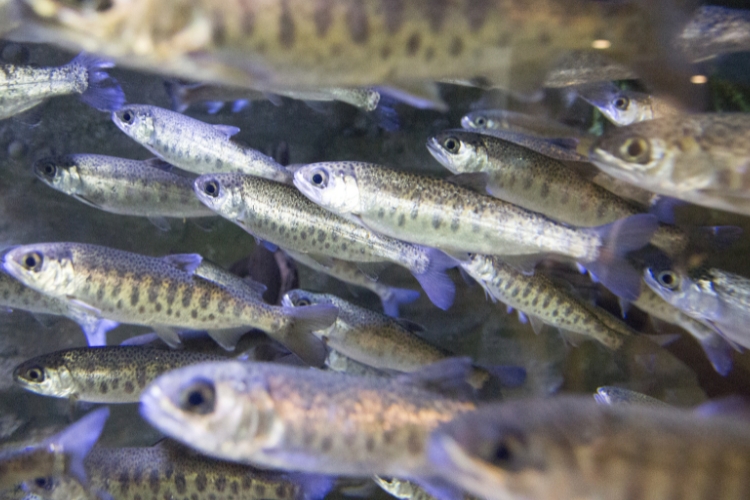Surviving Pipelines: Young Pacific Salmon Respond Differently to Oil Spills
By Eleonore Lebeuf-Taylor
10 August 2023

Every day, millions of litres of diluted bitumen from Alberta’s oil sands are carried by pipelines through critical salmon habitat on the way to British Columbian ports.
A spill can happen at any time, introducing toxic chemicals into the freshwater ecosystems where Pacific salmon spawn. For declining coho salmon populations, this could mean disaster —but we have yet to understand the full effects of a spill on the coho salmon life cycle. Researchers from the Department of Integrative Biology and Simon Fraser University have joined forces to find out.
In a study lead by Honours student Gabrielle Perugini, recently published in Aquatic Toxicology, the team shows that coho respond differently to oil spills depending on their life stage.
“A number of life stages —anything from eggs to pre-adult smolt— could be present in the waters depending on when the spill happens,” explains Dr. Sarah Alderman, the study’s senior author. “We wanted to understand if certain life stages were more sensitive than others to the diluted bitumen exposure.”
Diluted bitumen is a mixture of thousands of chemicals, and many of these are known to be toxic to fish. Once released into a freshwater environment, some of these chemicals dissolve in the water and are absorbed by fish, triggering responses at both the cellular and whole-organism level.
To understand how young coho salmon might be affected by a spill, the researchers measured cardiorespiratory performance and liver enzymatic activity of two juvenile stages (fry and parr) exposed to very low, environmentally relevant concentrations of diluted bitumen. The fish were tested at two time points —48 hours and four weeks— to understand both acute exposure and longer-term effects.
“Fry are the earliest life stage in which the fish can swim up from the gravel where they’ve been developing and are very small, about the size of your pinky finger,” explains Dr. Todd Gillis, a collaborator on the study. “The parr are up to a year older and about the size of your whole hand.”
Cardiorespiratory performance of exposed fish was assessed using a technique that involves removing oxygen from the water.
“We strip the oxygen from the water at a slow rate and measure the time it takes for the fish to lose equilibrium, or go ‘belly-up’, which means that their brain isn’t getting enough oxygen,” explains Alderman.
Both fry and parr exposed to diluted bitumen went belly-up faster than untreated fish, indicating cardiorespiratory impairment. Although fish in the lab fully recover from this test once they are returned to oxygenated water, this result has worrisome implications for wild fish.
“Cardiorespiratory impairment means the fish are less fit,” says Gillis. “They will be slower to catch prey, take longer to recover from exercise, and be less likely to escape a fast predator.”
To compound matters, exposed coho were also smaller in size than untreated ones, which can spell trouble for a species where larger size means better chances of survival.
The similar decrease between fry and parr in cardiorespiratory performance and growth, however, did not extend to the cellular level. To the researchers’ surprise, a closer look at the activity of a liver enzyme that helps detoxify some of the chemicals in diluted bitumen revealed that fry had higher baseline activity of the enzyme than parr.
“By four weeks, we were seeing differences between the life stages: the older parr had a more intense increase in enzyme activity,” says Alderman. “But the younger fry had a higher background level of liver enzymes, which we think offers some level of initial defence.”
Perhaps the most alarming part of this study is that it involved only very low concentrations of diluted bitumen. In fact, the concentrations to which the coho were exposed were not even close to those encountered in a large pipeline failure, making the study more akin to what would occur in the event of a small spill.
“By the end of our four-week exposure, the World Health Organization would consider that water drinkable,” explains Alderman. “Yet at that point, the fish were still showing the same decreased cardiorespiratory performance.”
It means that even small oil spills can be dangerous, especially since the water-soluble compounds present in diluted bitumen can be carried downstream and contaminate freshwater environments far from the spill site.
“We know this from real-life spills where —even though the physical spread of oil is stopped— chemicals from the oil are detected in the water miles downstream,” says Alderman.
Ultimately, Alderman hopes that this work will help inform spill preparedness and response.
“It’s clear that coho salmon can be affected even when we think they’re a safe distance away,” says Alderman. “And if a very sensitive life stage gets exposed, we may need more long-term efforts to ensure that those salmon stocks aren’t completely wiped out.”
For a species like coho salmon, which is facing the combined threats of pollution and climate change, understanding the full effects of crude oil contamination will play a crucial role in any future conservation effort.
This study was funded by Fisheries and Oceans Canada.
Read the full study in the journal Aquatic Toxicology.
Read about other CBS Research Highlights.